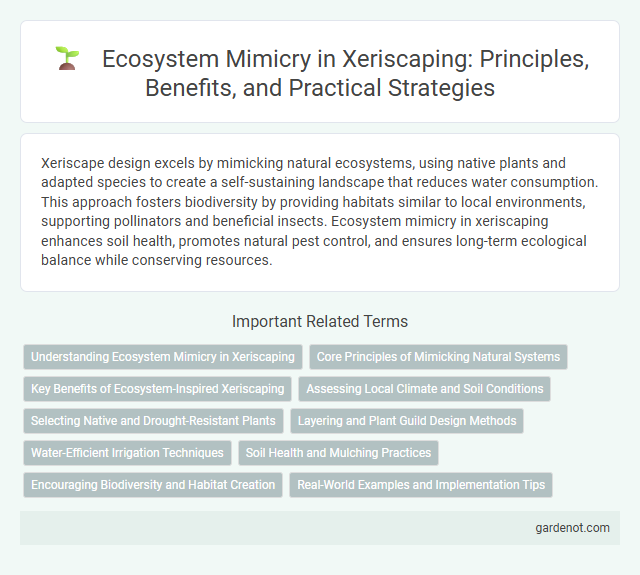Xeriscape design excels by mimicking natural ecosystems, using native plants and adapted species to create a self-sustaining landscape that reduces water consumption. This approach fosters biodiversity by providing habitats similar to local environments, supporting pollinators and beneficial insects. Ecosystem mimicry in xeriscaping enhances soil health, promotes natural pest control, and ensures long-term ecological balance while conserving resources.
Understanding Ecosystem Mimicry in Xeriscaping
Ecosystem mimicry in xeriscaping involves replicating native ecosystems to create sustainable, water-efficient landscapes that support local flora and fauna. By selecting drought-tolerant plants and arranging them in natural patterns, xeriscapes enhance biodiversity while minimizing water usage and maintenance. This approach promotes ecological balance, soil health, and habitat creation, aligning landscaping practices with regional environmental conditions.
Core Principles of Mimicking Natural Systems
Core principles of mimicking natural systems in xeriscape emphasize using native plants that adapt to local climate and soil conditions, thereby reducing water consumption and maintenance needs. Soil health is enhanced through organic mulches and compost, promoting water retention and nutrient cycling similar to natural ecosystems. Designing multi-layered plant communities mimics natural biodiversity, fostering habitat resilience and supporting local wildlife populations.
Key Benefits of Ecosystem-Inspired Xeriscaping
Ecosystem-inspired xeriscaping enhances water conservation by replicating natural plant communities adapted to local climates, reducing irrigation needs by up to 50%. This approach promotes biodiversity by supporting native wildlife habitats and improving soil health through organic matter retention. Additionally, it increases landscape resilience to drought and extreme weather, lowering maintenance costs and environmental impact.
Assessing Local Climate and Soil Conditions
Xeriscape designs are most successful when they mimic natural ecosystems by carefully assessing local climate and soil conditions, ensuring plant selection aligns with regional precipitation patterns and temperature ranges. Detailed soil analysis, including pH levels, texture, and drainage capacity, informs the choice of drought-tolerant native species that thrive in existing soil environments. Understanding microclimates within a landscape further maximizes water efficiency by placing vegetation in locations best suited to their adaptive traits.
Selecting Native and Drought-Resistant Plants
Selecting native and drought-resistant plants enhances xeriscape's ecosystem mimicry by promoting biodiversity and supporting local wildlife habitats. These plants require minimal irrigation, thrive in arid conditions, and reduce soil erosion, contributing to sustainable water conservation. Integrating species adapted to regional climate optimizes landscape resilience and ecological balance.
Layering and Plant Guild Design Methods
Xeriscape ecosystem mimicry employs layering and plant guild design methods to replicate natural habitats, enhancing water efficiency and biodiversity. Layering involves arranging plants in vertical strata--trees, shrubs, groundcovers, and soil plants--to optimize resource use and microclimate regulation. Plant guild design integrates complementary species with supportive functions like nitrogen fixation, pollinator attraction, and pest control, creating resilient, self-sustaining xeriscape landscapes.
Water-Efficient Irrigation Techniques
Water-efficient irrigation techniques in xeriscaping, such as drip irrigation and subsurface watering, closely mimic natural ecosystem processes by delivering water directly to plant roots, reducing evaporation and runoff. These methods promote soil moisture retention and support native drought-tolerant plant species, enhancing overall landscape sustainability. Implementing rainwater harvesting systems complements irrigation efforts by capturing and utilizing natural precipitation, further optimizing water use in xeriscape environments.
Soil Health and Mulching Practices
Ecosystem mimicry in xeriscaping emphasizes maintaining soil health through natural mulching practices that retain moisture and enhance microbial activity. Organic mulches like wood chips and leaf litter create a protective layer that prevents erosion, regulates soil temperature, and supports nutrient cycling vital for drought-resistant plant growth. Integrating these practices fosters resilient xeric landscapes by replicating natural desert soil ecosystems.
Encouraging Biodiversity and Habitat Creation
Xeriscape techniques promote ecosystem mimicry by incorporating native and drought-tolerant plants that support local wildlife, enhancing biodiversity and creating vital habitats. This landscaping approach reduces water usage while providing food, shelter, and breeding grounds for pollinators, birds, and small mammals. By replicating natural ecosystems, xeriscaping fosters resilience and sustainability in urban and arid environments.
Real-World Examples and Implementation Tips
Xeriscape design often incorporates ecosystem mimicry by replicating native plant communities seen in arid regions like the Sonoran Desert and Mediterranean climates to conserve water and support local biodiversity. Real-world examples include the Phoenix Desert Botanical Garden's approach of layering drought-tolerant succulents, grasses, and shrubs to mimic natural desert ecosystems, enhancing resilience and aesthetic appeal. Implementation tips emphasize selecting region-specific native plants, improving soil with organic mulch to retain moisture, and grouping plants by water needs to optimize irrigation efficiency while sustaining ecosystem functions.
Ecosystem mimicry Infographic

 gardenot.com
gardenot.com